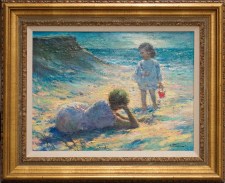Thompson, Richard Earl

Artist Bio: Richard Earl Thompson's legacy to the world is the gift of enduring beauty - nature captured on canvas in all its myriad moods. An American Impressionist of renown, he has been compared to Monet, but preferred to think of himself as “an extension” to the impressionists “a continuing link.” Profoundly influenced by the Master of the French Impressionist School, he also embraced ideas from Spanish, Italian and American painters. Creating his own unique style by incorporating a broader 20th Century color palette, which included earth tones, and combining painting techniques, Thompson's canvases convey a powerful and harmonious combination of diversified subject matter, exquisite brush work, skillful draftsmanship and luminosity. A child prodigy at the Chicago Academy of Fine Art at the age of 15, he was taken under the wing of Frederick Grant, who was a student of William Merritt Chase, one of America's great painters. From there he continued at the American Academy of Art and then on to the Chicago Art Institute to study under Louis Ritman. He felt strongly that the fundamental training of drawing, color and composition instilled in those early days provided him the sound basis from which to develop his mature technique. Both musically and artistically gifted, at the age of 18 he made the decision to pursue a career in art rather than opera. He felt that he had to paint in order to live fully. Thompson often compared art to music, feeling that they were akin, only communication in a different form. The combination of the Depression with the insurgence of the Modern Art Era, and the necessity of supporting a family, led Thompson to choose an early career in commercial art. Many will look back with a tinge of nostalgia recalling the back covers of the 'Saturday Evening Post,' some of which Thompson was responsible for while working with Haddon Sundblom who created many of the famous Coca-Cola ads. Also among his commercial art credits are the famous World War II War bond Posters, which he was commissioned to paint by the U.S. Government. Distinguished and highly successful as his commercial art career was he never gave up his ambition to have the 'fine art' career for which he had been trained. In 1959 with commercial illustration being replaced slowly by photography, he turned to fine art as a full time career. He credited his commercial art background with aiding him in his ability to do figures so well and to combine landscapes and figurative works so dramatically. Sensitive to nuance, Thompson lived a very special life among nature in the woods of Wisconsin and on the shores of the Florida Key with his supportive and lovely wife, Mary Munn during his highly productive years of fine art. Collections Leigh Yawkey Woodson Museum R.W. Norton Art Gallery Pierce Gallery Sears Roebuck Brigham Young University De Sasset Museum John Hopkins Hospital Marquette University Naval Art Collection, Pentagon, Washington, DC Robert Louis Stevenson Academy Wintergreen (Taliesen East) Recreational Complex University of Washington The Lewer Agency, Inc. Audley Farm Southland Financial Corporation Art Galleries of Wisconsin Memorial Park Continental Illinois Bank Numerous private collections.